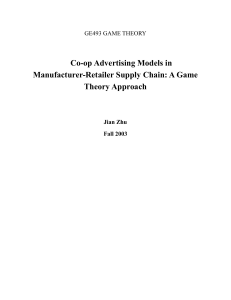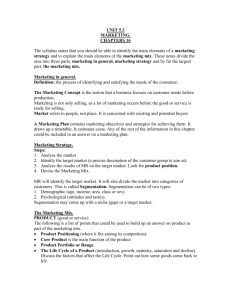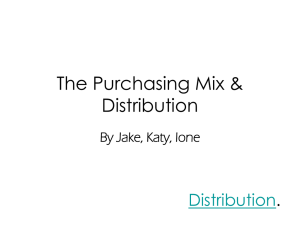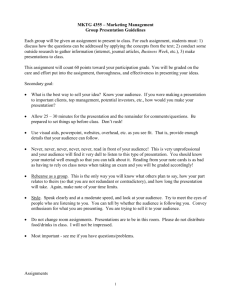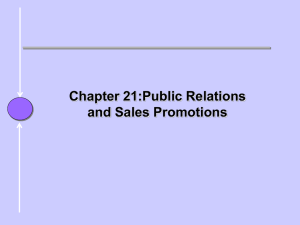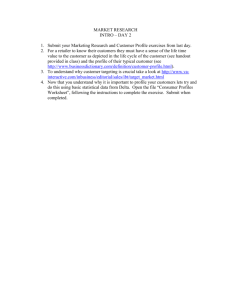Cooperative Advertising in a Distribution Channel with Fairness
advertisement
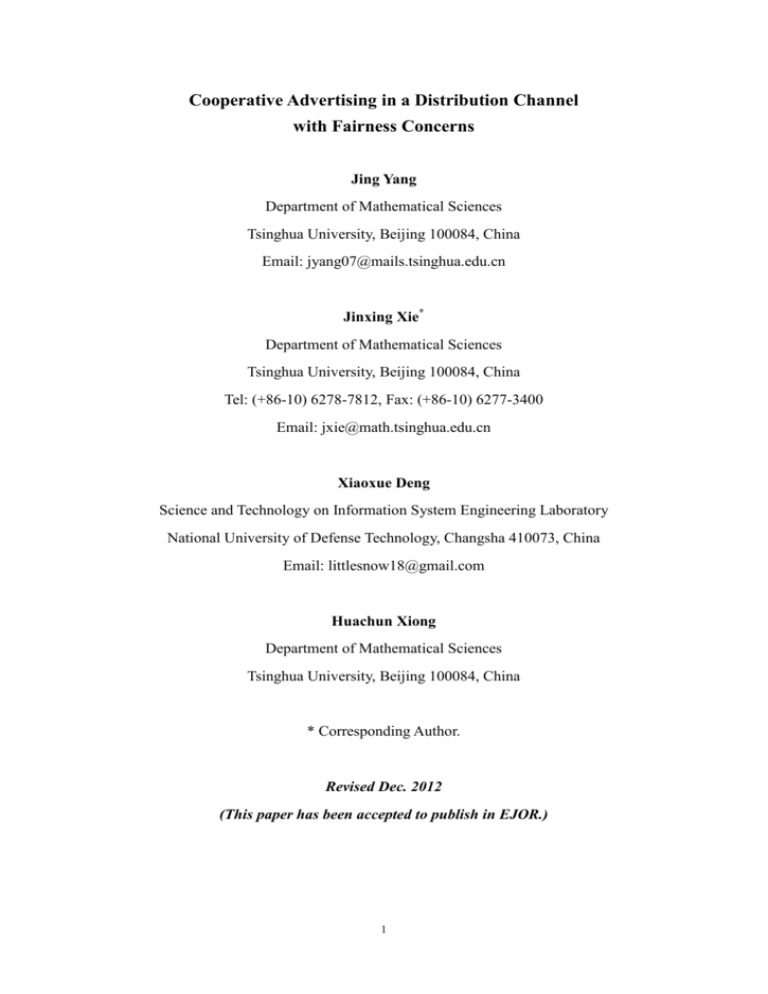
Cooperative Advertising in a Distribution Channel
with Fairness Concerns
Jing Yang
Department of Mathematical Sciences
Tsinghua University, Beijing 100084, China
Email: jyang07@mails.tsinghua.edu.cn
Jinxing Xie*
Department of Mathematical Sciences
Tsinghua University, Beijing 100084, China
Tel: (+86-10) 6278-7812, Fax: (+86-10) 6277-3400
Email: jxie@math.tsinghua.edu.cn
Xiaoxue Deng
Science and Technology on Information System Engineering Laboratory
National University of Defense Technology, Changsha 410073, China
Email: littlesnow18@gmail.com
Huachun Xiong
Department of Mathematical Sciences
Tsinghua University, Beijing 100084, China
* Corresponding Author.
Revised Dec. 2012
(This paper has been accepted to publish in EJOR.)
1
Cooperative Advertising in a Distribution Channel with Fairness
Concerns
Abstract: Cooperative (co-op) advertising has been widely used in practice and
employed as a strategy to improve the performance of a distribution channel. It is
known from the existing models that co-op advertising could not achieve the channel
coordination (i.e., maximize the total channel profit). In this paper, we consider a
distribution channel consisting of a single manufacturer and a single retailer, and
investigate the effect of the retailer's fairness concerns. Applying the equilibrium
analysis, we obtain the following results: (1) Channel coordination can be achieved if
the retailer has fairness concerns and model parameters satisfy certain conditions. (2)
Although both channel members become better off with co-op advertising if neither
channel member has fairness concerns, we find situations where co-op advertising
brings detrimental effects to the retailer if the retailer has fairness concerns. (3) The
retailer’s fairness concerns may increase or decrease the equilibrium participation rate,
the equilibrium advertising effort, and the equilibrium profit of the manufacturer and
the whole channel. (4) We identify the conditions under which the effectiveness of
co-op advertising can be improved or reduced by the retailer’s fairness concerns. As
long as co-op advertising can bring extra profit to the manufacturer, the retailer's
fairness concerns could improve the effectiveness of the co-op advertising. (5) There
exists a Pareto improvement for the profits of both the manufacturer and the retailer
when a retailer without fairness concerns becomes fair-minded.
Keywords: Marketing; Cooperative advertising; Fairness concerns; Channel
coordination; Game theory
2
1. Introduction
In a typical distribution channel consisting of one manufacturer and one retailer,
cooperative (co-op) advertising is often used to boost sales (Ahmadi-Javid and
Hoseinpour 2012, Huang and Li 2001, Xie and Wei 2009). Co-op advertising, which
the manufacturer pays a portion of the retailer’s advertising costs, is very popular in
the current marketing practice. Many companies, such as IBM, Apple Computer, Intel,
use this strategy (Brennan 1988, Clark 2000, Elkin 1999). Nagler (2006) conducts a
large-scale empirical study for 2286 brands, and reveals that more than 60% of them
(1142 brands) adopt co-op advertising.
Co-op advertising has also attracted much attention in the academic field (see, for
example, Aust et al. 2012, Berger 1972, Bergen and John 1997, Dant and Berger 1996,
Huang et al. 2002, He et al. 2011, Kim and Staelin 1999, SeyedEsfahani et al. 2011,
Zhang et al. 2012). For more information regarding the game-theoretic models on
cooperative advertising see a recent review by Xie and Zhang (2011).
Almost all of the existing studies on co-op advertising consider only rational
channel members, who always try to maximize their own profit. However, many
evidences show that decision makers care not only about their own profit, but also
about whether their profit is higher or lower than the others’. These are often referred
to as fairness concerns of the decision makers. The perception of fairness plays an
important role in consumer decision making (Bolton et al. 2003, Feinberg et al. 2002,
Kahneman et al. 1986, Xia et al. 2004). For example, Fehr and Schmidt (1999)
present both theoretical and experimental findings that players dislike unequal
outcomes compared to the payoffs of their opponents, and are willing to sacrifice a
monetary amount to reach an outcome that they believe to be more fair. Moreover,
fairness concerns also play an important role in developing and maintaining channel
relationships
(e.g.,
manufacturer-retailer
relationships).
Many
empirical
or
experimental studies show that manufacturers and retailers would also sacrifice their
own profits to improve the counterparts’ margin because of fairness concerns (see
Kumar 1996, Loch and Wu 2008, Olmstead and Rhode 1985, Scheer et al. 2003).
Therefore, it is important to study co-op advertising when channel members have
3
fairness concerns. In this paper we propose a game-theoretic model in which one
manufacturer sells a single product through one retailer. The retailer uses advertising
to boost the sales, and the manufacturer shares a proportion of the advertising cost
(i.e., adopts the co-op advertising). We characterize the equilibrium results in the
following two cases: (1) neither channel member has fairness concerns; (2) only the
retailer has fairness concerns. (We assume that the manufacturer is the leader of the
channel, so it is reasonable to only consider the retailer’s fairness concerns.) By
comparing the results in the above two cases, we obtain the following results.
(1) Although co-op advertising cannot coordinate the whole channel when
neither channel member has fairness concerns, it can coordinate the whole channel in
some cases where the retailer has fairness concerns. Similar findings are also
established in other situations (see Cui et al. 2007, and Demirag et al. 2010).
(2) When neither channel member has fairness concerns, co-op advertising
always brings benefit to the retailer, as well as the manufacturer and the whole
channel. However, when the retailer has fairness concerns, we give situations in
which co-op advertising brings detrimental effects to the retailer.
(3) The retailer’s fairness concerns may affect the equilibrium participation rate
of the manufacturer, the equilibrium advertising effort of the retailer, and the
equilibrium profits of the manufacturer and the whole channel. Whether the existence
of fairness concerns has positive or negative effect depends on the value of the
equitable ratio for the retailer, which is a ratio in the retailer’s belief that characterizes
what is an equitable outcome (if the retailer’s profit over the manufacturer’s equals to
this equitable ratio, the retailer regards it as an equitable outcome). If the equitable
ratio is low, the retailer’s fairness concerns decrease the equilibrium participation rate,
the equilibrium advertising effort, and the equilibrium total channel profit, and
increase the manufacturer’s equilibrium profit. If the equitable ratio is high, the
opposite results hold.
(4) The effectiveness of co-op advertising for the manufacturer may be improved
or reduced by the retailer’s fairness concerns: As long as co-op advertising can bring
extra profit to the manufacturer, the retailer's fairness concerns could improve the
4
effectiveness of the co-op advertising.
(5) There exists a Pareto improvement of the profits of the manufacturer and the
retailer when a retailer without fairness concerns becomes fair-minded, in other words,
the manufacturer may not try to avoid dealing with a fair-minded retailer even if he
can eliminate the retailer's fairness concerns at no cost.
The rest of the paper is organized as follows. Section 2 considers the basic case
that neither channel member has fairness concerns. Section 3 discusses the case that
the retailer has fairness concerns. In Section 4, we investigate the influence of the
retailer’s fairness concerns on the equilibrium results and the effectiveness of co-op
advertising. Finally, in Section 5 we conclude the paper and put forward some future
research directions. All the proofs are collected in the Appendix.
2. Model without fairness concerns
Consider a distribution channel with one manufacturer and one retailer. The
manufacturer produces an infinitely divisible product and sells it to consumers
through the retailer. Let M be the gross profit margin of the manufacturer and R
be the gross profit margin of the retailer, where M , R 0 are constants.
Furthermore, we assume M R 2 to avoid trivial cases. (If M R 2 it is not
profitable for the manufacturer to adopt co-op advertising, which is not in this paper’s
consideration.) Market demand of the product depends on the level of the advertising
effort devoted by the retailer:
S ( A) T kA ,
(1)
where T 0 is the sales saturate asymptote, k 0 denotes the effectiveness of
advertising, and A is the level of advertising effort devoted by the retailer. T stands for
the quantity demanded in the market if there is no advertising, while k is the retailer's
ability to change the advertising into the demand of the product. We consider a single
sales season when the retail price is a constant, and the market demand is independent
of the retail price (Aust and Buscher 2012, Huang et al. 2001, 2002, Zhang et al.
2012). As our work is the first one that discusses the effect of the retailer's fairness
5
concerns in co-op advertising, we adopt the basic market demand function, a function
of the advertising effort alone, to work out the theoretical solutions.
The cost corresponding to the advertising effort A is A2/2, which is an
extensively-accepted assumption in co-op advertising literature (Chintagunta and Jain
1992, Chu and Desai 1995, Desai 1997, Nair and Narasimhan 2005, Sigue and
Chintagunta 2008).
To set up a benchmark for our analyses later on, we first consider the centralized
case, in which there is a central planner making decision for the whole channel. The
centralized decision problem is to choose a level of advertising effort A to maximize
the total channel profit C (A) :
Max C ( A) ( M R )S ( A) A 2 / 2 ( M R )(T kA) A 2 / 2 .
A0
(2)
It can be easily verified that Problem (2) has a unique solution
AC* k ( M R ) ,
(3)
and the optimal profit for the whole channel is
*C ( M R )T ( M R ) 2 k 2 / 2 .
(4)
Then we turn to the decentralized situation. First we summarize the notation of
the paper for the ease of reference in Table 1.
Manufacturer (M) uses co-op ad.
M does not use co-op ad.
Retailer (R) has
fairness concerns
CF
t CF ; ACF ; CF
i , i M , R, C;U R
t NF ; A NF ; iNF , i M , R, C;U RNF
R doesn't have
fairness concerns
t CN ; ACN ; CN
i , i M , R, C
t NN ; A NN ; iNN , i M , R, C
Table 1. Notation.
In Table 1, t, A, and U stand for the equilibrium participation rate, the
equilibrium advertising effort, the equilibrium profit, and the equilibrium utility of the
retailer respectively. The subscripts ‘M’, ‘R’, and ‘C’ respectively stand for the
manufacturer, the retailer and the total channel. The first letter ‘C’ in superscript ‘CF’
6
and ‘CN’ denotes that the manufacturer adopts co-op advertising, while the first letter
‘N’ in superscript ‘NF’ and ‘NN’ denotes that the manufacturer does not adopt co-op
advertising. The second letter ‘F’ in both ‘CF’ and ‘NF’ stands for the case that the
retailer has fairness concerns, while the second letter ‘N’ in both ‘NN’ and ‘CN’ stands
for the case in which the retailer does not have fairness concerns.
In the decentralized situation the manufacturer and the retailer play a Stackelberg
game. The timing of events is as follows. First, the manufacturer decides the
participation rate t [0,1) . (Here we exclude the trivial case t=1, in which the retailer
will devote infinite advertising effort but undertake no cost.) Then, observing t, the
retailer decides the level of advertising effort A. All parameters are common
knowledge to both members. In the decentralized situation, if the equilibrium total
channel profit equals to *C , we say the channel is coordinated, or co-op advertising
coordinates the channel.
This co-op advertising model has been widely discussed in other studies when the
retailer does not have fairness concerns. For any given participation rate t [0,1) of
the manufacturer, the retailer’s and the manufacturer’s profits with advertising effort
A are
R ( A | t ) R S ( A) (1 t ) A2 / 2 R (T kA) (1 t ) A2 / 2 ,
(5)
M ( A | t ) M S ( A) tA 2 / 2 M (T kA) tA 2 / 2 .
(6)
We employ the standard backward induction to solve this game. In Table 2, we
list the equilibrium results including the participation rate, the advertising effort and
profits of the manufacturer, the retailer and the whole channel.
7
Case
No co-op advertising
Participation rate
0
Advertising effort
A NN R k
ACN
Manufacturer’s
profit
MNN M T M R k 2
CN
M M T
Retailer’s profit
Total channel profit
t CN
RNN RT
CNN ( M R )T
Co-op advertising
R2
2
k2
(2 M R ) R 2
k
2
2 M R
2 M R
k (2 M R )
2
(2 M R ) R 2
k
4
CN
R RT
CN
C ( M R )T
(2 M R ) 2 2
k
8
(2 M R )(2 M 3 R ) 2
k
8
Table 2. Equilibrium results when channel members do not have fairness concerns
NN
CN
NN
CN
NN
Proposition 1. AC* ACN A NN , *C CN
C C , R R , M M .
Proof. The proof of this proposition, as well as other propositions, is provided in the
Appendix.
The results in Proposition 1 are similar to and consistent with existing studies
(e.g., Berger 1972, 1996, Bergen and John 1997). From Proposition 1, we have the
following two observations. First, co-op advertising encourages the retailer to make
greater efforts on advertising, and furthermore, the manufacturer, the retailer and the
whole channel will be better off with co-op advertising. Second, if neither channel
member possesses fairness concerns, co-op advertising cannot lead to channel
coordination.
3. Model with retailer possessing fairness concerns
We consider the case that the retailer has fairness concerns, but the manufacturer
does not. The manufacturer maximizes his own profit whereas the retailer maximizes
his utility depending on the profits of both members. For any given participation rate
t [0,1) dictated by the manufacturer, the retailer's utility function is
U R ( A | t ) R ( A | t ) max ( M ( A | t ) R ( A | t )), 0
max ( R ( A | t ) M ( A | t )), 0,
8
.
(7)
where 0 is the equitable ratio for the retailer (in other words, the retailer deems
the outcome as equitable if R ( A | t ) M ( A | t ) ; see Cui et al. 2007), 0
measures
the retailer’s
disutility of earning less than the
manufacturer
(disadvantageous inequality), and [0,1] measures the retailer’s disutility of
earning more than the manufacturer (advantageous inequality). Many studies have
shown that subjects suffer more from inequity that is to their monetary disadvantage
than from inequity that is to their monetary advantage (Fehr and Schmidt 1999, p.
822), which means . Other assumptions are the same as in Section 2.
Using backward induction, we characterize the retailer’s best response for any
given participation rate t [0,1) . The retailer chooses A(t) 0 to maximize his utility
defined in Eqn. (7). The decision problem can be divided into the following two
subproblems:
max U R ( A | t ) R ( A | t ) M ( A | t ) R ( A | t )
A0
s.t. M ( A | t ) R ( A | t )
max U R ( A | t ) R ( A | t ) R ( A | t ) M ( A | t )
A0
s.t. M ( A | t ) R ( A | t )
(8)
(9)
(10)
(11)
Subproblem (8)-(9) corresponds to the case that the retailer feels disadvantageous
inequality and Subproblem (10)-(11) corresponds to the case that the retailer feels
advantageous inequality. In both subproblems, the objective functions and constraints
are quadratic. After solving these two subproblems, we derive the manufacturer’s
decision respectively to find out the best choice of the manufacturer, in other words,
the equilibrium results of the game.
Proposition 2. When the manufacturer adopts co-op advertising with the fair-minded
*
CF
*
retailer, (a) If ( 1 , 4 ] , then t CF tC* , ACF AC* , CF
C CC , M MC ,
*
CF
*
CF
CF
CF
R RC , and U R U RC . In this case, R M ,
*
CF
*
CF
*
(b) If (0, 1 ] , then t CF t * , ACF A* , CF
C C , M M , R R ,
9
CF
and U RCF U R* . In this case, CF
R M ,
*
CF
*
CF
*
(c) If ( 4 ,) , then t CF t* , ACF A* , CF
C C , M M , R R ,
CF
and U RCF U R* . In this case, CF
R M ,
where
1
( R2 M2 )k 2 2 R T
,
2 M ( M R )k 2 2 M T
CF
,
4 arg ( CF
M MC )
(12)
(13)
and t i* , Ai* , *ji , U Ri* , i C, , , j M , R, C stand for the analytic forms of the
equilibrium solutions, which are showed in Table 3.
Part (a) of Proposition 2 indicates that if the retailer has fairness concerns, the
whole channel can be coordinated by co-op advertising under certain conditions (i.e.,
1 4 ). It is well known when profit maximization is used as the objective,
channel coordination cannot be achieved. Once the fairness concerns are introduced
into the model, the objective changes from profit maximization to utility
maximization. Since the objective function changes, certain conditions with certain
parameters actually determine the ratio of profits between the manufacturer and the
retailer, which will force the manufacturer's participation rate and the retailer's
advertising effort to move to the channel optimal levels, even in Stackelberg set up,
therefore channel coordination is achieved. This is the main reason why two channel
members can coordinate the channel with certain parameters under the retailer's
fairness concerns.
To demonstrate the results in Proposition 2 more clearly, we provide a numerical
example in which T 0 , k 1 , M 1 , 0.7 , 0.3 . The numerical results
are showed in Fig. 1 (A), in which Region I corresponds to Part (a) of Proposition 2,
Region II corresponds to Part (b) and Region III corresponds to Part (c).
10
2
2
1.8
1.8
1.6
1.6
1.4
1
II
1.2
1
4
3
1.4
II
1.2
0.8
1
I
0.8
I
0.6
0.6
0.4
0.4
III
0.2
0
2
0
0.2
0.4
0.6
0.8
1
1.2
1.4
1.6
1.8
III
0.2
0
2
0
0.2
0.4
R/M
0.6
0.8
1
1.2
1.4
1.6
1.8
2
R/M
(A) Examples for Proposition 2
(B) Examples for Proposition 3
Fig. 1. A demonstration for Proposition 2 and 3.
For the purpose of comparisons, we next provide equilibrium results of the
situation that the manufacturer does not adopt co-op advertising (i.e., t=0) when the
retailer has fairness concerns.
Proposition 3. When the manufacturer does not adopt co-op advertising with the
ˆ* ,
ˆ * , NF
fair-minded retailer, (a) If ( 2 , 3 ] then A NF Ae* , CNF
M
Me
Ce
ˆ * , and U NF Uˆ * . In this case, NF NF ,
RNF
R
Re
Re
R
M
ˆ * , NF
ˆ *M , RNF
ˆ *R , and
(b) If (0, 3 ] then A NF Aˆ * , CNF
M
C
U RNF Uˆ R* . In this case, RNF MNF ,
ˆ * , NF
ˆ * , NF
ˆ * , and
(c) If ( 3, ) , then A NF Aˆ* , CNF
M
R
M
C
R
U RNF Uˆ R* . In this case, RNF MNF ,
where
2
3
(1 )(2T R k 2 )
R
,
( T 2 (1 ) 2 2T R k 2 R2 k 4 (1 )(T R k 2 )) M
(1 )(2T R k 2 )
R
,
( T 2 (1 ) 2 2T R k 2 R2 k 4 (1 )(T R k 2 )) M
(14)
(15)
ˆ *ji Uˆ * , , i e, , , j M , R, C , stand for the
satisfying 1 2 3 4 . Aˆ i* ,
Ri
analytic forms of the equilibrium solutions, which are showed in Table 4.
Part (a) of Proposition 3 indicates that if the retailer has fairness concerns, he may
feel equal to the manufacturer, but the whole channel cannot be coordinated without
11
co-op advertising. To better describe Proposition 3, we present a numerical example
in which the parameters are the same as in the previous example. The numerical
results are demonstrated in Fig.1 (B), in which Region I corresponds to Part (a) of
Proposition 3, Region II corresponds to Part (b) and Region III corresponds to Part (c).
Comparing (A) and (B) in Fig.1, we find that for the fair-minded retailer with the
same parameters, the equitable region is larger when the manufacturer adopts co-op
advertising.
It is important to note that we use the equitable ratio γ to describe the boundaries
of all the propositions in the paper. Here the equitable ratio is a function of other
parameters, such as the sales saturate asymptote T, the effectiveness of advertising k,
the disadvantageous inequality and the advantageous inequality . We use γ to
describe all the boundaries because we can get the explicit (closed-form) solutions in
this way, while it is difficult for us to do so for the other parameters in the model.
When neither channel member has fairness concerns, it is shown in Proposition 1
that co-op advertising makes both channel members, as well as the whole channel,
(strictly) better off. An interesting question is: Does the same result remain true when
the retailer has fairness concerns? Obviously, as the channel leader, the manufacturer
certainly benefits from co-op advertising. Next proposition will tell us whether the
retailer and the whole channel also benefit from co-op advertising.
Proposition 4. (a) The following statements are always true:
ACF ANF ,
CF
NF
NF
~
CF
M M , C C , where “=” hold if and only if [ 1 , 1 ] .
(b) U RCF may be greater or smaller than U RNF . In particular, U RCF U RNF if
(0, min{ 1 , ~1}) ( 2 , ~2 ] ;
U RCF U RNF
if
( 1 , 2 ] (~2 ,) ; and
U RCF U RNF if [~1 , 1 ] ,
where
~1
~2
(2 M R ) 1
,
3 M
1 R
M
.
(16)
(17)
12
Part (a) of Proposition 4 indicates that when the retailer has fairness concerns, the
manufacturer and the whole channel will not be worse off with co-op advertising than
without it. In particular, when satisfies certain conditions, i.e., [~1 , 1 ] , the
manufacturer will set the participation rate to zero and thus doesn’t participate in
co-op advertising. Part (b) of Proposition 4 reveals that co-op advertising can be either
detrimental or beneficial to the retailer, depending on the values of model parameters.
If the retailer doesn’t have fairness concerns, by co-op advertising the manufacturer
can improve the total sales as well as both channel members’ profits. However, if the
retailer has fairness concerns, he cares not only his own profit but also the
manufacturer’s. Although the retailer’s profit may increase when is big enough if
the manufacturer adopts co-op advertising, the profit that the retailer believes to
deserve may increase faster, which in fact will reduce the retailer’s utility. In
particular, when ( 1 , 2 ] , although with a lower profit and a lower utility, the
retailer feels more equal with the manufacturer when the manufacturer applies co-op
advertising. On the other hand, even with a higher profit and a higher utility, the
retailer feels more advantageous when the manufacturer doesn’t apply co-op
advertising. This interesting phenomenon implies that the retailer’s fairness concerns
provide the manufacturer one more choice to improve the profit, and the manufacturer
prefers to let the retailer feel equal rather than advantageous.
From Proposition 4 we can draw a conclusion that co-op advertising may be
beneficial to both the manufacturer and the whole channel, but, in the meantime, it
may be unfavorable for the retailer. Moreover, the retailer's fairness concerns should
be paid more attention to by the manufacturer because they provide an extra choice
for the manufacturer to increase his profit.
4. Influence of fairness concerns
In this section, we investigate the influence of fairness concerns over equilibrium
results and the effectiveness of co-op advertising.
Proposition 5.
13
(a) (Participation rate) If (0, ~3 ] , t CF t CN ; if (~3 ,) , t CF t CN .
(b) (Advertising effort) If (0, min{ 1 , ~1}] , ACF ACN ; if (min{ 1 , ~1},) ,
ACF ACN .
(a) (Total
channel
profit)
If
(0, min{ 1 , ~1}] ,
CN
CF
C C
;
if
CN
.
(min{ 1 , ~1},) , CF
C C
~ ,) , CF
CN ; if (
(b) (Manufacturer’s profit) If (0, ~4 ] , CF
,
M CN
4
M M
M
where
~3
2 R (2 M R )T 2 M R ( M R )k 2
,
2 M (2 M R )T (2 M2 M R R2 )( M R )k 2
(4 M 3 R ) R k 2 8 RT
~
.
4
(2 M R ) 2 k 2 8 M T
(18)
(19)
Proposition 5 characterizes the influence of fairness concerns over equilibrium
results when the manufacturer adopts co-op advertising, including the participation
rate, the advertising effort, the manufacturer’s profit and total channel profit. Since the
retailer’s objective functions are different in the cases of “CF” and “CN” (utility v.s.
profit), we will not compare results regarding the retailer. Proposition 5 indicates that
the existence of the retailer’s fairness concerns may lead to mixed effects on the
equilibrium results. The existence of the retailer’s fairness concerns diminishes the
participation rate, the advertising effort, and the total channel profit if is low,
while it enhances them if is high. The opposite is true for the manufacturer’s
profit. We only provide the intuition behind the results when is low, and it's
similar with high . When is low, the fair-minded retailer tends to believe he
deserves a lower profit comparing to the manufacturer’s. If he earns a profit
considerably higher than what he believes to deserve, he will feel advantageous
inequality (or, regret), which leads him to lower the level of advertising effort, with
the result of lowering the manufacturer's profit. Anticipating this, the manufacturer
tends to set a lower participation rate to mitigate this negative effect. Thus the
14
equilibrium participation rate is lowered by the retailer’s fairness concerns if is
low. A lower participation rate of the manufacturer makes the retailer less active in
local advertising, which lowers the advertising effort and total channel profit which
only depends on the advertising effort. Thus, the equilibrium advertising effort and the
profit of the whole channel is also lowered by the retailer’s fairness concerns if is
low. As explained above, when is low, the retailer tends to feel advantageous
inequality. To decrease this advantageous inequality and to increase his own profit,
the retailer tends to make a decision favored by the manufacturer. Thus, the
manufacturer’s equilibrium profit is increased by the retailer’s fairness concerns if
is low. Further research shows that similar results are also true for cases “NF” v.s.
“NN” (but the conditions are slightly different). We omit them here to save space.
Next we investigate the influence of fairness concerns over the effectiveness of
co-op advertising.
NF
CN
NN .
Proposition 6. (a) If [~1 , 1 ] , then 0 CF
M M M M
NF
CN
NN .
(b) If (0, ~1 ) ( 1 ,) , then CF
M M M M
Proposition 6 implies that the retailer’s fairness concerns may bring beneficial or
detrimental influence over the effectiveness of co-op advertising. From Proposition 4
NF , so the effectiveness of co-op advertising
we get that if [~1 , 1 ] , then CF
M M
is reduced by the retailer’s fairness concerns. Otherwise, as long as the manufacturer
can achieve extra profit using co-op advertising with the fair-minded retailer, the
effectiveness of co-op advertising is improved by the retailer’s fairness concerns. It is
intuitive to understand Proposition 6 by considering the fact that the situation in
which the retailer does not have fairness concerns is the special case of the situation
with the fair-minded retailer. So, when the case changes from 'NF' to 'CF', the
manufacturer has more choices than from 'NN' to 'CN', and he will achieve a higher
profit as long as he can.
Next we consider whether there exists a Pareto improvement of the profits of both
15
channel members. Without qualitatively affecting the results presented below, we
assume that the manufacturer can change a fair-minded retailer into a retailer without
fairness concerns at no cost if the manufacturer chooses to do so.
CN
Proposition 7. (a) If (~5 , R / M ) , then CF
.
R R
(b) If [~5 , ~4 ] [ 1 , 4 ] , then there exists a Pareto improvement for the profits of
the manufacturer and the retailer when a retailer without fairness concerns becomes
fair-minded,
where
~5
(2 M R ) R k 2 4 RT
.
( M R ) 2 k 2 M2 k 2 4 M T
(20)
It is important to note that in Case 'CN', the retailer does not have fairness
concerns, and he maximizes his profit. On the other hand, in Case 'CF', the retailer
maximizes his utility. In Case 'CF' the retailer feels equal under the condition of
[ 1 , 4 ] , and maximizing his utility equals to maximizing his profit; therefore we
can compare the retailer's profits in Case 'CN' and 'CF' with this condition.
Part (b) of Proposition 7 indicates that if a retailer without fairness concerns
becomes fair-minded, the profits of both the manufacturer and the retailer may not
decrease. Specially, if [~5 , ~4 ] [ 1 , 4 ] , both channel member's profits can
increase. That is to say, the manufacturer may not have any incentive to unilaterally
eliminate the retailer’s fairness concerns even if it is possible and incurs no cost.
These findings not only suggest that the effect of the retailer's fairness concerns on
co-op advertising is sustainable but also indicate that both channel members may
benefit from the retailer’s fairness concerns and the manufacturer may even try to
facilitate such concerns for strategic reasons. We give a numerical example with the
same parameters as the example in Figure 1 before. The shaded region in Figure 2 is
the Pareto improvement region.
16
2
1.8
1
4
1.6
~5
~4
1.4
1.2
1
0.8
0.6
0.4
0.2
0
0
0.2
0.4
0.6
0.8
1
1.2
1.4
1.6
1.8
2
R/M
Fig. 2. A demonstration for Proposition 7.
5. Conclusion
In this paper, we take an initial step to incorporate fairness concerns of channel
members into the study of co-op advertising in a distribution channel consisting of a
single manufacturer and a single retailer. It is well known that if neither channel
member has fairness concerns, the channel cannot be coordinated by co-op
advertising. However, when the retailer has fairness concerns, the channel can be
coordinated by co-op advertising under certain conditions. The essential reason is that,
with fairness concerns, the retailer's utility is related to the manufacturer's profit. By
co-op advertising, the manufacturer can improve his own profit as well as the
retailer's utility based on the retailer's fairness concerns. When the profits of the
manufacturer and the retailer are positively correlated, maximizing the manufacturer's
profit is equivalent to maximizing the channel's profit, which then leads to the channel
coordination.
Our analysis also shows that co-op advertising may be detrimental to the retailer
with fairness concerns. The retailer's fairness concerns may improve or reduce the
effectiveness of co-op advertising to the manufacturer, the equilibrium participation
rate, the equilibrium advertising effort, as well as the equilibrium profits of the
manufacturer and the whole channel. Interestingly, there exists a Pareto improvement
17
of both the profits of the manufacturer and the retailer when a retailer without fairness
concerns becomes fair-minded. In other words, the manufacturer may not try to avoid
dealing with a fair-minded retailer even if he can eliminate the retailer's fairness
concerns at no cost. These results suggest the sustainability and persistency of the
effect on the retailer's fairness concerns on co-op advertising. From our study, we
know that both the manufacturer and the retailer should attach importance to fairness
concerns, which may bring benefits to both channel members.
There are several directions deserving future research. First, we assume the
manufacturer to be the Stackelberg leader in this paper, but there are practical
examples of large retailers (e.g., Walmart) as channel leaders. Thus it is an interesting
direction that the retailer acts as the Stackelberg leader of the channel. Second, as
Pavlov and Katok (2009) mentioned, if some information of the retailer is private, the
manufacturer may have different strategies. Third, Ho and Su (2009) show that
fairness concerns are more significant among peers. So it is more interesting to study
a channel with a single manufacturer and multiple retailers who possess peer-induced
fairness.
Acknowledgements
This work is supported by the NSFC Projects Nos. 70971072 and 71031005. The
authors sincerely thank the editor and the anonymous referees, whose insightful and
constructive comments led to a substantial improvement of the paper.
Appendix A. Supplementary material
Supplementary material associated with this article can be found in the online version.
References
Ahmadi-Javid, A., & Hoseinpour, P. (2012). On a cooperative advertising model for a
supply chain with one manufacturer and one retailer. European Journal of
Operational Research, 219 (2), 458-466.
Aust, G., & Buscher, U. (2012). Vertical cooperative advertising and pricing
decisions in a manufacturer–retailer supply chain: A game-theoretic approach.
European Journal of Operational Research, 223 (2), 473-482.
Bergen, M., & John, G. (1997). Understanding cooperative advertising participation
18
rates in conventional channels. Journal of Marketing Research, 34(3), 357-369.
Berger, P. D. (1972). Vertical cooperative advertising ventures. Journal of Marketing
Research, 9(3), 309-312.
Bolton, L. E., Warlop, L., & Alba, J. W. (2003). Consumer perceptions of price
(un)fairness. Journal of Consumer Research, 29(3), 474-491.
Brennan, L. (1988). How retailers are putting it all together? Sales and Marketing
Management, 5, 62-65.
Chintagunta, P. K., & Jain, D. (1992). A dynamic model of channel member strategies
for marketing expenditures. Marketing Science, 11(2), 168-188.
Chen, Y., & Cui, T. H. (2010). The benefit of uniform price for branded variants.
Working paper.
Chu, W., & Desai, P. S. (1995). Channel coordination mechanisms for customer
satisfaction. Marketing Science, 14(4), 343-359.
Clark, S. (2000). Dual destiny. Adweek, 41, 60-66.
Cui, T. H., Raju, J. S., & Zhang, Z. J. (2007). Fairness and channel coordination.
Management Science, 53(8), 1303–1314.
Dant, R. P., & Berger, P. D. (1996). Modeling cooperative advertising decisions in
franchising. Journal of the Operational Research Society, 49(9), 1120-1136.
Demirag, O. C., Chen, F. & Li, J. B. (2010). Channel coordination under fairness
concerns and nonlinear demand. European Journal of Operational Research,
207(3), 1311-1326.
Desai, P. S. (1997). Advertising fee in business-format franchising. Management
Science, 43(10), 1401–1419.
Elkin, T. (1999). Co-op crossroads. Advertising Age, 70(47), 1 and 24-26.
Fehr, E., & Schmidt, K. M. (1999). A theory of fairness, competition and co-operation.
The Quarterly Journal of Economics, 114(3), 817-868.
Feinberg, F. M., Krishna, A., & Zhang, Z. J. (2002). Do we care what others get? A
behaviorist approach to targeted promotions. Journal of Marketing Research,
39(3), 277-291.
He, X., Krishnamoorthy, A., Prasad, A., & Sethi, S. (2011). Retail competition and
cooperative advertising. Operations Research Letters, 39(1), 11-16.
Ho, T.-H., & Su. X. (2009). Peer-induced fairness in games. The American Economic
Review, 99(5), 2022-2049.
Huang, Z., & Li, S. X. (2001). Co-op advertising models in a manufacturer-retailer
supply chain: A game theory approach. European Journal of Operational
Research, 135(3), 527-544.
Huang, Z., Li, S. X., & Mahajan, V. (2002). An analysis of manufacturer-retailer
supply chain coordination in cooperative advertising. Decision Sciences, 33(3),
469-494.
Kahneman, D., Knetsch, J., & Thaler, R. (1986). Fairness as a constraint on profit
seeking: entitlements in the market. The American economic review, 76(4),
728-741.
Kim, S. Y., & Staelin, R. (1999). Manufacturer allowances and retailer pass-through
rates in a competitive environment. Management Science, 18(1), 59-76.
19
Kumar, N. (1996). The power of trust in manufacturer-retailer relationships. Havard
Business Review, 74(6), 92-106.
Loch, C. H., & Wu, Y. (2008). Social preferences and supply chain performance: an
experimental study. Management Science, 54(11), 6-38.
Nagler, M. G. (2006). An exploratory analysis of the determinants of cooperative
advertising participation rates. Marketing Letters, 17(2), 91-102.
Nair, A., & Narasimhan, R. (2005). Dynamics of competition with quality-and
advertising-based goodwill. European Journal of Operational Research, 175(1),
462-474.
Olmstead, A. L., & Rhode, P. (1985). Rationing without government: The west coast
gas famine of 1920. The American economic review, 75(5), 1044-1055.
Pavlov, V., & Katok, E. (2009). Fairness and coordination failures in supply chain
contracts. Working Paper.
Scheer, L. K., Kumar, N., & Steenkamp, E. M. (2003). Reactions to perceived
inequity in U.S. and Dutch interorganizational relationships. Academy of
Management Journal, 46(3), 303-316.
SeyedEsfahani, M., Biazaran, M., & Gharakhani, M. (2011). A game theoretic
approach to coordinate pricing and vertical co-op advertising in
manufacturer–retailer supply chains. European Journal of Operational Research,
211(2), 263-273.
Sigue, S. P., & Chintagunta, P. (2008). Advertising strategies in a franchise system.
European Journal of Operational Research, 198(2), 655-665.
Xia, L., Monroe, K. B., & Cox, J. L. (2004). The price is unfair! A conceptual
framework of price fairness perceptions. The Journal of Marketing, 68(4), 1-15.
Xie, J., & Wei, J. C. (2009). Coordinating advertising and pricing in a
manufacturer-retailer channel. European Journal of Operational Research,
197(2), 785-791.
Xie, J., & Zhang, J. (2011). A review of game theoretical models in cooperative
advertising. In R. M. Samson (Eds.), Supply-Chain Management: Theories,
Activities/Functions and Problems (pp. 193-215). New York: Nova Publishers.
Zhang, J., Gou, Q., Liang, L., & Huang, Z. (2012). Supply chain coordination through
cooperative
advertising
with
reference
price
effect.
Omega,
http://dx.doi.org/10.1016/j.omega.2012.03.009
20
Case
Participation
rate
Advertising
effort
Manufacturer’s
Case (a) (disadvantageous inequality)
t*
(1 )[(2 M R )(1 ) 3 M ]
(1 )[(2 M R )(1 ) M ]
A*
((2 M R )(1 ) M )k
2(1 )
Retailer’s profit
profit
A*
[(2 M R )(1 ) M ]2 k 2
8(1 )(1 )
*R RT
[(2 M R )(1 ) M ]
8(1 ) 2 (1 )
*R RT
[(2 M R )(1 ) M ]
8(1 ) 2 (1 )
U R* ((1 ) R M )T
[ R (1 ) M ]
4(1 )
*C ( M R )T
[(2 1) M2 (2 M R ) R ]k 2 2( M R )T
*MC
[ R (1 ) M ]
4(1 )
2
*C ( M R )T
[(2 M R )(1 ) M ]
8(1 ) 2
[(2 M 3 R )(1 ) M ]k 2
( M R )[k 2 ( M R ) 2T ]
2(1 )
*RC
( M R )[k 2 ( M R ) 2T ]
2(1 )
*
U RC
( M R )[k 2 ( M R ) 2T ]
2(1 )
*C
( M R )[k 2 ( M R ) 2T ]
2
[3 (1 ) R 2(1 ) 2 R 2 2 M ]
U R* ((1 ) R M )T
(1 )( M R ) 2 k 2
AC* ( M R )k
[(1 )(2 M R ) M ]k 2
[(2 M R )(1 ) M ]
8(1 ) 2
[(2 M 3 R )(1 ) M ]k
t C*
((2 M R )(1 ) M )k
2(1 )
*M M T
[(1 )(2 M R ) M ]k 2
Total channel
(1 )[(2 M R )(1 ) 3 M ]
(1 )[(2 M R )(1 ) M ]
[(2 M R )(1 ) M ]2 k 2
8(1 )(1 )
[3 (1 ) R 2(1 ) 2 R 2 2 M ]k 2
Retailer’s utility
t *
*M M T
profit
Cases (c) and (d) (coordination)
Case (b) (advantageous inequality)
Table 3. Equilibrium results when the manufacturer adopts co-op advertising and retailer has fairness concerns.
21
RNF MNF (disadvantageous inequality)
Case
Advertising
Manufacturer’s
profit
ˆ *M M T M ( R (1 ) M )k
(1 )
Retailer’s utility
Total channel
profit
( R (1 ) M )( R (1 ) M )k
2(1 ) 2
2
ˆ *Me M T M kAˆ e*
ˆ *R RT
ˆ *R RT
Retailer’s profit
( R M ) 2 k 2 2( R M )T
ˆ *M M T M ( R (1 ) M )k
(1 )
2
( R (1 ) M )( R (1 ) M )k
2(1 ) 2
2
Uˆ R* ((1 ) R M )T
Uˆ R* ((1 ) R M )T
[ R (1 ) M ]2 2
k
2(1 )
[ R (1 ) M ]2 2
k
2(1 )
( R (1 ) M )((2 M R )(1 ) M )k
2(1 ) 2
2
Aˆ e*
*
*
ˆ
ˆ
Re R T R kAe
2
2
*
ˆ*
Uˆ Re
Re
ˆ *C ( R M )T
ˆ *C ( R M )T
2
RNF MNF (equality)
Aˆ e* ( R M )k
( (1 ) M )k
Aˆ * R
(1 )
( (1 ) M )k
Aˆ* R
(1 )
effort
RNF MNF ( advantageous inequality)
( R (1 ) M )((2 M R )(1 ) M )k
2(1 ) 2
2
2
Aˆ eq*
*
*
ˆ
ˆ
Ce ( R M )(T kAe )
2
Table 4. Equilibrium results when the manufacturer doesn’t adopt co-op advertising and retailer has fairness concerns
22

